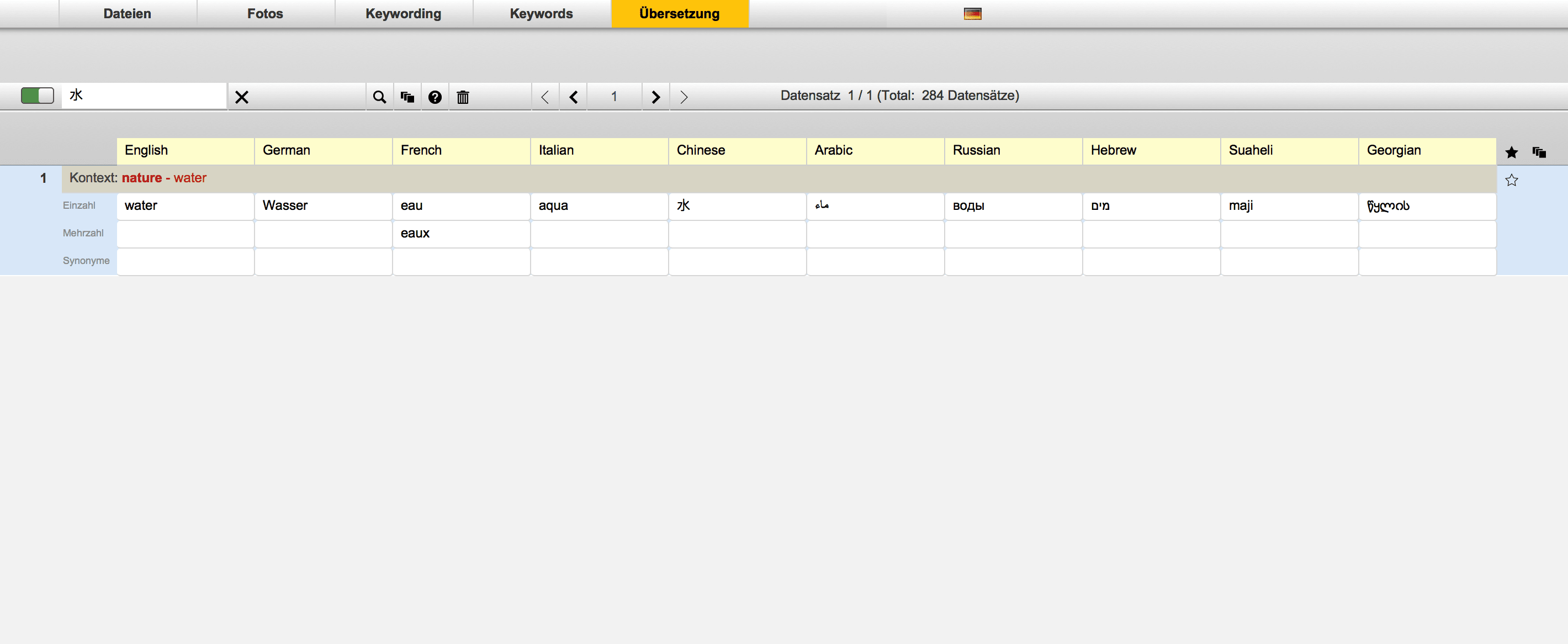Keywording software with a new update
Keywording software with a new update
KIM Keywording 3.70 is a maintenance update and offers the following improvements:
- Updated components for better integration with macOS High Sierra
- IPTC data are written back to the files in UTF-8 encoding, which means better support for different writing systems for IPTC data is achieved.
- Various small improvements.
The update of the keywording software can be downloaded directly here:
KIM Keywording is keywording software that supports up to 10 keywording languages. The database-based solution offers a hierarchical keyword structure, intelligent wizard functions, QuickLists and much more help for fast, consistent and professional keywording.
KIM keywording is available for Mac and Windows and data can be exchanged with external employees, for example. If you have external keywording files, you can write them back into the image files with the help of KIM keywording.
Read more about KIM keywording here:
Update: KIM Keywording 3.6
KIM Keywording 3.6 released
KIM Keywording 3.6 is a maintenance update, which is recommended for installation by all users.
Bug fixes
- A bug has been fixed where IPTC data could not be saved back to the files under MacOSX High Sierra.
- Various small bug fixes and improvements.
KIM Keywording is a multilingual keywording softwae for photographers and photo agencies. We have a special topic page, focussed on Keywording.
Nothing found.
Keywording from the point of view of the image user
Keywording from an image users viewpoint
Whenever you are offering photos, you do so in order that other people can find and use them. To enable someone else to find and use photos, keywords and metadata must be added. This work must be done first, and only later it will show if the work brings the desired results. For this reason it is helpful to include the viewpoint of an image user in the process of keywording.
Change camp
So you are busy preparing your photos and you want to design the keywording so that as many people as possible can find your photos. Then nothing is better than changing camp once. Go from being an image provider to an image user. Become a picture seeker.
Imagine that you are looking for a photo of an egg. A picture of an egg is required for a new campaign, which – according to the default – should have certain characteristics. Now there are thousands upon thousands of pictures of eggs on the net (e.g. here ). Not all are suitable for the campaign, however. A differentiation is therefore required, which is achieved by adding further features. Because the yellow of the egg is not always the yellow of the egg.
Anyone who slips into the skin of the picture seeker will often find new search terms and perspectives. Perhaps it is important to explicitly state the number of eggs, the color of the eggs, the environment (kitchen, nest, egg carton), the type (ostrich, quail, snake egg). Should it be a studio shot or should it be photographed in the wild? Which expression should be conveyed and who should the image address? All of these questions lead to possible new keywords.


Ask colleagues and friends
Keywording is complex because people use language and words differently. Put yourself in the shoes of the viewfinder already brings a lot. Next, you could invite other people to do your job – just as a test. Take a picture or two and ask friends, colleagues and acquaintances to describe each picture using around 10 search terms. You will probably see that very different terms are used. Our understanding of language was shaped individually. This diversity is the real challenge for good keywording. It is a question of a good differentiation between the terms used and an appropriate number of synonyms.
There is this famous story in which you ask six different people to describe the same room. There are six completely different descriptions. If you describe pictures, you ideally imagine different people and try to capture the optimal words for different perspectives.
Know the image users
If image databases are provided for clearly defined user groups or for very specific topics, it is essential to have a good understanding of both the user group and the topic used. The same images can make very different statements depending on the context of use – and therefore require adapted keywords. In companies it is often the case that their own marketing language or their own thematic focus is explained with certain words, abbreviations or concepts. So if you work for a specific topic or a specific clientele, it is wise to take into account the very own language that is spoken there.
In addition to technical terms, it can be, for example, certain abbreviations, areas of application (marketing, archive), events (Meeting Day 2014) or purposes (campaign 2017, winter 2018, etc.). For all these special terms, it is always very helpful if the keyworder either comes from the company itself (and therefore knows the terms and concepts by heart) or is briefed in detail by the company. At most, cooperation is also a good option.


Keywording should lead to results
Language is alive like people are alive. There can be no exact 100% valid and all-encompassing keywording, especially since the way the images are viewed and interpreted changes over time. At best, an approximation of optimal results can be achieved. It therefore takes the courage to leave gaps as well as the foresight for later purposes. When keywording you should think results-oriented: Which terms lead to good search results? That should be the real guide.
The actual goal of keywording is to make the images findable for the image user. All keywording serves this purpose. If the image user finds what he is looking for, then the purpose is fulfilled. If he doesn’t find the picture, then the keyworder has overlooked something important. The interaction between keyworders and image users is therefore particularly helpful. It is worth getting regular feedback from users. Only the successful image search determines the quality of the keywording. If possible, it is worth analyzing the search queries on the website. Which words are used? Are several search terms entered to narrow down a search? Are there search terms for which no hits were found? If that’s the case, why is that? With questions of this kind one learns to better assess the search behavior and the efficiency of the assigned keywords.
Some websites allow the analysis of search queries. If, for example, an image does exist in your image database but does not appear in searches, then there is a problem with keywording. An image is not found because relevant search terms are missing. If you recognize this, then you can Optimize keywording . Such an analysis allows conclusions to be drawn about user behavior and user needs without having spoken directly to those affected.
In the light of these considerations, it makes sense to set up your own Keywording strategy that activates an evaluation at critical points, after which the keywording results can be adjusted.
Picture credits: All pictures come from the picture offer of Italic picture agency .
Optimize your keywording
How can you optimize your keywording?
Photographers, photo agencies, image researchers are all linked through information. Information about the images. Information describing the images. Keywording is key to sell, retrieve, find or manage photos, whether on sales platforms, in internal databases or elsewhere. Properly assigned keywords enable a photographer to communicate with the potential customer. The quality of keywording to a large extent defines the value of the images, as images which cannot be found logically have no value at all.
There seem to be endless possibilities to optimize your own keywording. Which optimizations though make sense? Take into consideration the platforms you will publish your images to, as these all come with certain functions which influence the way you (should) keyword. This becomes especially clear if you need to decide which keyword-variants should be added. Should you use singulars only, or add plurals as well? How about synonyms, declensions and word combinations (expressions)? Which ones add value and which are obsolete?
Differentiate
All the information you put together is meant to help the image researcher find the proper assets. Who is searching for "three kids" should be presented with a nice selection of children in a group of three. However, if the word "kid" or "kids" is not available, and you only can search for "child" or "children", the results returned might be zero. How to optimize this scenario? There are 2 options: Either by better keywording you have to add plurals and synonyms, or the search engine has some intelligent features and includes a synonyms database which is used during searching. As a rule of thumb: The less intelligence the search engine has, the more keywords should be added (and vice versa).
Experience shows that many image researchers only use few keywords to search with. If that search does not return results, it is quickly interpreted that no images are available – and people leave your website for other options. But probably you have the right images, and the researcher or client only struggles with wrong or insufficient keywords. People search differently. Good keywording acknowledges the different ways people search. To add synonyms can be a solution (add "kid" as a synonym to "child").
Not every keywording software allows to add plurals or synonyms. KIM Keywording works with a hierarchical keyword structure in which every position in the hierarchy has fields for singulars, plurals as well as synonyms.
Platform and image users
If you process images for several platforms you will see that these platforms frequently require different keywording approaches. Optimizing keywords for a specific platform can immediately increase sales or improve search results. Harmonizing keywording is a key to optimize search results. To do so you need to know what the requirements for each platform are.
Specialized archives or internal databases often need specific keywords to match the focus, topic or industry. There even can be phrases which have no use outside a company, but are essential within the company (for example: corporate wording, shooting references, the names of marketing campaigns, etc.). For these situations and to optimize keywording you need knowledge about the special words and phrases.
Criteria for exclusion
Keywording needs several components for a sound approach: An analysis of technical options, the differentiation in keywords used and so-called criteria for exclusion. Criteria for exclusion are words used to exclude certain images. A word like "nobody" (synonym: "noone") can be used to find images which have no people in it. This is a helpful word to exclude certain images from your search, which would be difficult to achieve otherwise.
A criterion for exclusion also can be a category. Let's say you want a team image, but not in a business setting, you would search for "team" and the exclusion criterion would be "business". The search results would then show you images of teams, but leave out all the business style images. To add categories (general keywords) to your keywording greatly improves the image searchers ability to limit search results to his needs. If and how it is possible to exclude keywords from a search is different from website to website. As a keyworder you should prepare for it.
Benefits of general keywords
To summarize our findings so far: A keywording optimization can be achieved by a well-differentiated set of keywords, which include descriptive and precise keywords (boy, keychain, beach house, running…) along with more general phrases (people, architecture, business, sport…). More general keywords greatly improve the quality of keywording as they help to narrow down search results. To use a software with a hierarchical keyword structure let's you add both types of keywords –entire strings– to your images.
Conceptional keywording
Apart from the description of the image content there are also conceptional keywords. "Retirement" or "health" are abstract keywords of this category. "Success", "Network", "Team" are more of these. Some conceptional keywords are easy to assign to certain images, while others are more difficult (though frequently the difficult ones are the important ones!).
Generally speaking the adding of conceptional keywords to images is tricky. It is not about what you see, but about how you interpret images. The interpretation of images though can change over time. A word like "modern" can be outdated in a few years. Conceptional keywords need a strategy, not just for the keywording itself, but also for maintenance over the years.
These thoughts are not complete and always must be evaluated against the background of your situation and needs. The following questions might help to get an evaluation started.
Evaluate the optimization
- How intelligent is the search engine on your platform? Is there a database integrated which can cover declensions, synonyms, plurals and other linguistic specialties?
- If you have some database included in your search engine: Which type of database and logic is used and can these databases be edited?
- Do you need to add singulars, pluras, synonyms?
- Do you have any internal phrases you need to include in your keywording (corporate wording, project names, etc.)
- How long is the time span the images will be available for search? What is the best approach to make it work for that time span?
- Do you have a keywording software which can cover your needs?
KIM Keywording 3.4 released
KIM Keywording 3.4 released
Today we released KIM Keywording 3.4. This upgrade has some minor bug fixes and also adds a new dropdown menu with special features for automated keywording.
Your own keywording strategy
Development of your own keywording strategy
Anyone who wants to market their pictures well as a photographer has to take care of the keywording. Photos cannot be marketed without a description of the image and search terms. For many photographers this is not an enjoyable task, but a necessary evil. You didn't become a photographer for nothing, and not a taxonomy specialist.
But a virtue can be made out of necessity. Those who solve keywording efficiently are better off than those who solve it poorly or not at all. Efficiency means: the best result in the shortest possible time. Efficiency is favored by a simple strategy. If the software then supports this strategy, keywording can become a fruitful routine work.
In 3 steps to efficient keywording
- Create a description of the image
- Use the image description as a starting point for keywording
- Complete the most important standard terms
The image description is highly relevant for recording on Google and other search engines. A good description of the picture supports and simplifies the keywording. In KIM Keywording, our in-house keywording software, the image description can be evaluated with the wizard function. All words for which there are hits in the keyword database are displayed for selection - including the complete keyword structures. In KIM Keywording, creating an image description speeds up the keywording process. If anything is missing, please add the words. At the end you look for additional standard terms. In KIM Keywording, this is done with the QuickLists.
What are standard terms?
Standard terms are those that are used repeatedly for your images. Of course, there are big differences when you work as an outdoor photographer or as a museum photographer. Whatever is relevant to you should be readily available when you tag your images. Standard terms should also and especially be helpful for those who are looking for their pictures. There should also be auxiliary words to help narrow down the search results better. So these would be criteria for inclusion or exclusion.
Such terms are, for example
- Thematically relevant: landscape types, age groups of people, activities that have been photographed a lot ...
- Situational: indoor / outdoor, day / night, studio / event ...
- Exclusive: Nobody (no people visible) ...
- Dominant colors: blue, orange, green, multicolored ...
- Frequently used names of events, people, buildings ...
- Image properties: HDR, monochrome, vector graphics ...
- Viewing angle: from above, from below, from the side, looking into the camera ...
Such words should be very easily accessible in your keywording software. So-called QuickLists are available in KIM Keywording, which can be freely filled with terms from the keyword structure. When applying, not only the one word, but also the hierarchical keyword structure is taken along. QuickLists are therefore always available and thus allow a high degree of consistency in terms of keywords.
Strategic approach
Anyone who proceeds strategically with keywording can achieve high quality by repeating the same process over and over again. You achieve efficiency by optimizing this process. The software can help with this, but it is equally important that you have a clear picture of what you want to achieve with the keywording.
- Who should find your pictures? How and what is searched for?
- On which platforms would you like to publish your pictures? What are the requirements for keywording?
- How should subsequent improvements be maintained?
- Which options should be taken into account for the future (multilingualism, data export)
Think results-oriented. You may need to adjust your keywording strategy for different projects. Do this if it improves the result. The photographer is not the user of the image. What the photographer thought of the picture is often of little relevance. The decisive factor is how the end user can find the image. If, for example, certain expressions apply within an industry or company culture, if certain abbreviations are used or if a certain language is spoken, then this should be taken into account in the keywording.
A bridge is built with keywording. It is the bridge between the image (the photographer) and the end user of the images. Keywording can be considered successful if the bridge can be used by many.
KIM Keywording 3 released
New: KIM keywording 3
Kursiv Software has just released the new version of its in-house keywording software. The software can be obtained immediately from kursiv-software.com. KIM Keywording 3 is a professional keywording software that was developed for the requirements of photo agencies, photographers and professional keyword services. The new version trumps with a greatly modernized and simplified user interface as well as the integration of new technologies. This made it possible to significantly improve several work processes.
KIM Keywording 3 is a professional keywording software that was developed for the requirements of picture agencies, photographers and professional keywording services. The new version trumps with a greatly modernized and simplified user interface as well as the integration of new technologies. This made it possible to improve several work processes.
You can find more information and a test version on the Italic keywording pages .
https://kursiv-software.com/product/kim-keywording-3/
Multilingual keywording
Multilingual keywording, is that possible?
Keywording programs are almost always limited to just one language. This is mainly due to the fact that most software solutions for keywording are so-called file browsers and rely on the metadata in the files themselves. Standards apply to this metadata, but they do not yet have a definition for several languages. The IPTC consortium , which defines the defacto standard, has been struggling for a good solution in this regard for years. It currently only stands for most keywording programs a Keywording language available in the IPTC definition.
Websites with multiple languages can therefore not rely on the metadata from the images alone. A multilingual website either requires online translation or the delivery of keywords in several languages. If the keywords are created in several languages, they are usually much better than an online translation can ever do. KIM Keywording allows you to create consistent keywording for up to 10 languages at the same time, and to export this information for the website or for distribution.
Multilingual keywording with KIM keywording
KIM Keywording has a multilingual keyword database. The principle works as follows:
- The keyword structure is built up with the help of the first language
- Additional languages can then be added for each entry
- With keywording, the extra languages are written in separate database fields for each image
- All languages are exported when the metadata is exported
- Complete metadata sets can be easily distributed or used for your own website development
- All processes are standardized and thus ensure a consistent workflow.
https://kursiv-software.com/product/kim-keywording-3/
https://kursiv-software.com/product/kim-keywording-3/
File browser or database?
File browser or database?
KIM Keywording is a database and not a file browser. This is what distinguishes KIM Keywording from many other keywording programs. Using a database has many advantages for professional keywording. The differences between file browsers and database solutions are briefly explained here.
Most programs that support keywording are so-called file browsers. They read the files in a directory and, when you click on a file, show the metadata contained in this file. In other words, file browsers only refer to the images themselves.
KIM Keywording, on the other hand, is a database. When importing images, a separate data record is created for each file. The database is, so to speak, an extra level of information. With this extra level, additional information can now be recorded for which there are no IPTC fields: Additional languages for keywords, license information, releases, project names and project codes, notes for pictures with problematic topics (drugs, violence, nudity, ...) and the like. In addition, the workflow can be better organized by providing information on project progress, keywording status and customer contacts.
KIM Keywording is a database, but does not save the images themselves, it only creates information above the pictures. Of course there is a link from each data set to the corresponding image. In contrast to a file browser, however, the database can also be viewed separately from the image files. The keywording does not take place directly with the image files, but is solved in the database. Only the result is (can) be saved back in the image files, provided that IPTC fields are provided for this.
A database can also be used, for example, if the images themselves are currently inaccessible. This can be the case if you use different drives. As long as the files have already been imported into KIM Keywording, you can edit, search, expand and also export the information.
There are many advantages of a database. Are there any disadvantages? Of course, there are also limitations, for example with regard to the data formats. KIM Keywording only supports JPEG files (as of August 2016). There are two reasons for this: Images that are sold online are almost exclusively available as JPEG files. That is the standard. On the other hand, not all metadata of all data formats can be read out in Filemaker. The self-imposed limitation on JPEG files is therefore a pragmatic approach. KIM Keywording is not intended to replace your previous file browser. As keywording software, KIM Keywording comes into play at a very specific point in your workflow, namely to the image processing and image selection and in front of publication. The effort for high-quality keywording should only be made for the best images.
Think of KIM Keywording as the database for your published images.
https://kursiv-software.com/product/kim-keywording-3/










